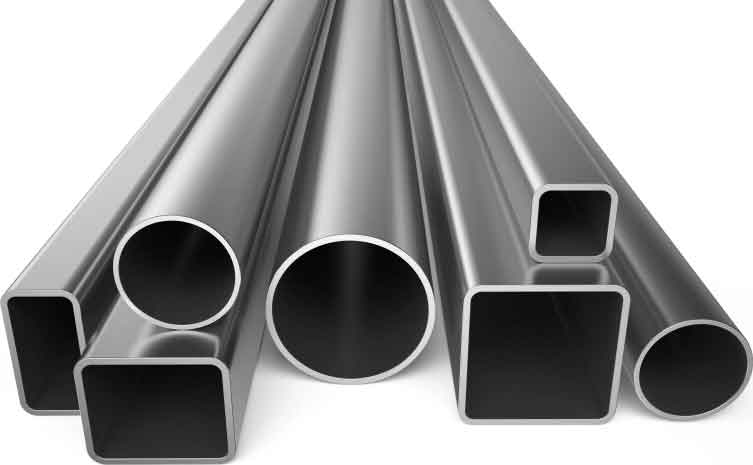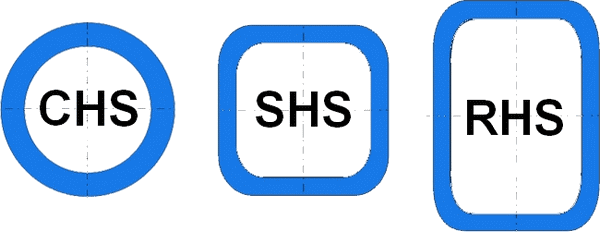What is a Hollow Structural Section?
Hollow Structural Sections (HSS) are steel sections in various shapes, such as round (CHS), square (SHS) and rectangular (RHS).
They are usually made from cold-rolled steel and formed into a hollow tube profile. This profile creates a gaping, unfilled edge that runs through the entire steel bar, hence the name "hollow section." Round and square HSS are the most commonly used types of structural hollow sections.

Purpose of Hollow Structural Sections
HSS are among the most versatile and efficient steel products available for construction, fabrication and mechanical purposes.
Aesthetically pleasing
Hollow structural profiles are sometimes the preferred material in buildings with exposed structural supports. This is because their clean lines, flat surfaces and smooth finish make them aesthetically pleasing. They are considered pleasing to the eye and give a simplistic modern look.
Hollow structural profiles often make up some of the most structurally sound and visually appealing buildings we know and love today.
Usable in multiple industries
They are very useful in multiple industries and applications. HSS are most commonly used in welded steel frames and columns. They are also regularly used in steel support beams due to their tremendous strength.
Hollow structural steel can be used for many different applications due to its high strength-to-weight ratio, economy and simplicity compared to other steel products. Therefore, it is very popular in many industries and for various construction applications.
Construction ease
A hollow profile has a smooth, flat surface along its edges. This simple profile makes construction with this material much easier.
In addition, edge preparation is minimal, which means it is much easier to join to other metal profiles. It requires only a clean, straight cut before being welded to another flat surface. These steel products are also valued for their ability to withstand high temperatures, pressure and other destructive elements.
Wide range of sizes
These steel sections also come in a wide range of shapes and sizes, meaning there is a wide selection for you to choose from. If your metal supplier does not have the size or shape you need, a hollow structural section can also be easily cut and customized to exact specifications.
Hollow structural sections can also contain different alloys, which improve their mechanical properties. In addition, they also come in many colors and finishes, which improve their environmental resistance.
Types of Hollow Structural Sections
As described above, structural hollow sections come in three main forms: rectangular hollow sections (RHS), square hollow sections (SHS) and round hollow sections (CHS). Each type of hollow section has its own advantages, properties and purposes.

Circular hollow sections (CHS) were the first type of hollow construction profile ever made. CHS are often used in building, mechanics and construction. They have clean and consistent lines, improved smoothness and no sharp or protruding edges.
Square Hollow Sections (SHS) are considered the intermediate form between CHS and RHS in terms of mechanical properties, aesthetics and structural behavior. They have a flat surface that requires little to no edge preparation and is ideal for joining and welding. SHS also has a symmetrical appearance similar to that of a CHS. Sometimes SHS is the ideal choice because it provides an ideal balance of strength, functionality and aesthetics for applications that require all three aspects.
Rectangular Hollow Sections (RHS) are also commonly used in building, mechanics and construction. However, they differ from CHS due to their flat surfaces. As a result, RHS may be a more structural and economical choice for some construction applications.
Specification standards for HSS
There are both American and European standards that govern the production and use of these materials and ensure that they meet the required safety, quality and performance criteria.
American Specifications for HSS
ASTM A500
-
Title: Standard Specification for Cold-Formed Welded and Seamless Carbon Steel Structural Tubing in Rounds and Shapes
-
Scope: This specification covers cold-formed welded and seamless carbon steel round, square, rectangular, or special shape structural tubing for welded, riveted, or bolted construction of bridges and buildings, and for general structural purposes.
ASTM A1085
-
Title: Standard Specification for Cold-Formed Welded Carbon Steel Hollow Structural Sections (HSS)
-
Scope: This specification covers cold-formed welded carbon steel hollow structural sections (HSS) for welded or bolted construction. These shapes are utilized in but not limited to the following applications: buildings, bridges, towers, cranes, sign supports and poles, off-shore production and drilling platforms, roll-over protective structures (ROPS), falling object protective structures (FOPS), and amusement rides.
European Specifications for HSS
EN 10210
-
Title: This part of the European Standard specifies technical delivery conditions for hot finished hollow sections of circular, square, rectangular or elliptical forms and applies to hollow sections formed hot, with or without subsequent heat treatment, or formed cold with subsequent heat treatment to obtain equivalent metallurgical conditions to those obtained in the hot formed product. Requirements for tolerances, dimensions and sectional properties are contained in EN 10210-2.
EN 10219
-
Title: This part of the European Standard specifies the technical delivery conditions for cold formed welded structural hollow sections of circular, square or rectangular forms and applies to structural hollow sections formed cold without subsequent heat treatment. Requirements for tolerances, dimensions and sectional properties are contained in EN 10219-2.
Main differences and similarities
Manufacturing process: ASTM standards distinguish between seamless and welded structures, while EN standards cover hot-formed (EN 10210) and cold-formed (EN 10219) products, focusing on final mechanical properties and dimensions.
Material grades: Both standards specify different material grades based on chemical composition and mechanical properties. European standards use part of the EN 10025 specifications to determine steel grades, while ASTM standards have their own grading system.
Scope of Application: ASTM A1085 was developed to address some of the design limitations of ASTM A500 and provides higher strength and improved performance for certain applications. Similarly, EN 10210 and EN 10219 provide options for hot- or cold-formed profiles, respectively, allowing engineers to choose materials based on specific structural or aesthetic requirements.
Geographical and regulatory context: The choice between American (ASTM) and European (EN) specifications often depends on the location of the project and local regulations. Engineers must comply with standards and codes that are required by law or generally accepted in the region where construction is taking place.
In short, the answer to the question
What is a Hollow Structural Section?
They are versatile steel products with practical, economic and aesthetic benefits, making them the ideal steel product for a variety of applications.
Related Post(s)

Dimensions and Weights Hollow Structural Sections (HSS), such as round (CHS), square (SHS) and rectangular (RHS)...